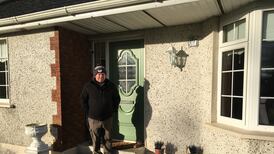A new environmental research centre opens at UCC tomorrow, focusing on everything from sea turtles to atmospheric chemistry, writes Dick Ahlstrom
The Environmental Research Institute at University College Cork is serious about its research remit. Even the new building it calls home is part of an environmental experiment.
Minister for the Environment and Local Government Dick Roche will tomorrow preside over the official opening of the Institute's new building. The €13 million centre will conduct a wide range of research related to the environment and our place in it, explains the ERI's manager, Dr Paul Bolger.
The institute formed in 2000 and has been involved since in highly interdisciplinary research. "It is part of the unique aspect of environmental research that it is multidisciplinary," says Bolger.
UCC received funding from the Higher Education Authority's Programme for Research in Third Level Institutions and from Sustainable Energy Ireland to build the new €13 million research centre, something that will serve to increase linkages between researchers in different faculties, Bolger believes.
"The idea of the building itself is to have all the different researchers from different departments in one place so you get more synergy. It is specially designed with break-out areas where people can meet."
The building is still being fitted out and when complete will accommodate about 100 academic, postgraduate and postdoctoral researchers. About 30 or 40 have already taken up residence in the new centre, Bolger adds.
The ERI will focus its research activity on five key areas. These include marine and freshwater; biodiversity and ecotoxicology; environmental chemistry; sustainable energy and environmental engineering; and environmental microbial genomics.
This sounds somewhat removed from the environment as most people understand it, but in fact it is quite the opposite. The Institute will look at the environment and how we interact with it in all its various forms.
For example, within biodiversity one researcher is tracking the movements of a leatherback turtle as it meanders around the Atlantic, Bolger says.
It landed here last summer in an exhausted state. It was helped to recover and then was released to the wild, carrying with it a satellite tracking device.
It has travelled widely since, spending time off the African coast.
"We can track where its breeding grounds are and where it feeds." Its progress has been put up on a web site open to the public (www.turtle.ie).
Environmental chemistry has a dedicated lab where researchers can simulate the atmosphere and then make changes such as adding or removing pollutants or testing ways of removing chemicals that damage the ozone layer. Another group will look at how bacteria or enzymes could be used either to produce valuable chemicals or help clean up environmental pollution.
Marine resources and the coastal environment are under study by UCC's Coastal Marine Research Centre in Haulbowline, which will also have a presence at the ERI.
Environmental engineering comes to the fore at the ERI given the entire building serves as part of an huge experiment. The 3,000 square metre building has been build with the environment in mind, not just with solar panels or heat pumps but with elaborate monitoring equipment to measure the value of these green technologies, explains the ERI's Dr Marcus Keane.
He and Dr Denis Kelliher are joint directors of the "Green Building Project", the ERI building itself, work being overseen by the Informatics Research Unit for Sustainable Engineering.
"The main reason behind doing this is the new EU Energy Performance Building Directive," Keane explains.
This requires new and existing public and private buildings to carry an energy audit indicating energy efficiency.
It was decided early on that the latest in environmentally aware engineering practices should go into the ERI building even as it was being designed, he says. The result is a test bed building where every characteristic of the building and its fabric can be monitored and measured to assess its contribution, if any, to energy efficiency.
The ERI building has two types of solar panels, heat pumps for water heating, passive heating from the sun and cross ventilation. It even taps into geothermal water sources deep underground to help provide low cost heating.
The performance of all of this can be measured in detail, Keane says.
Developed in conjunction with research partners in the University of California Berkeley, the monitoring system will provide valuable data for measuring the benefit of green technologies.





